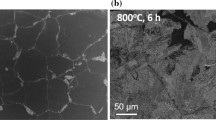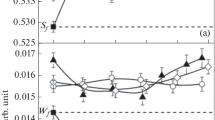Abstract
Positron annihilation spectroscopy (PAS), comprising of both positron lifetime and coincidence Doppler broadening measurements, has been employed for studying the phase decomposition behaviour of scandium doped Al–6Mg alloys. Micro structural and age hardening studies have also been conducted to substantiate the explanation of the results of PAS. Samples with scandium concentration ranging from 0 to 0.6 wt.% have been studied. The measured positron lifetimes of undoped alloy reveal that GP zones are absent in the as-prepared Al–6Mg alloy. The observed positron lifetimes and the results of coincidence Doppler broadening measurements largely stem from the entrap of positrons at the interface between aluminium rich primary dendrites and the magnesium enriched interdendritic eutectic mixture of Mg5Al8 (β) and the primary solid solution of aluminium (α). The study also provides evidence of the formation of scandium vacancy complexes in Al–6Mg alloys doped with scandium upto a concentration of 0.2 wt.%. However such complex formation ceases to continue beyond 0.2 wt.% Sc; instead, the formation of fine coherent precipitates of Al3Sc is recorded in the as prepared alloy containing 0.6 wt.% scandium. The positron annihilation studies coupled with CDBS have also corroborated with the fact that the fine coherent precipitates of Al3Sc are formed upon annealing the Al–6Mg alloys doped with scandium of concentration 0.2 wt.% and above. Transmission electron microscopic studies have provided good evidence of precipitate formation in annealed Al–6Mg–Sc alloys. Elevated temperature annealing leads to dissociation of the scandium-vacancy complexes, thereby leading to the enhancement of the mobility of magnesium atoms. This has facilitated fresh nucleation and growth of Mg5Al8 precipitates in the above alloys at 673 K.




















Similar content being viewed by others
References
Aiura T, Sugawara N, Miura Y (2000) Mater Sci Eng A 280:139
Gaber A, Afify N (1992) J Mater Sci 27:1342
Toropova LS, Eskin DG, Kharakterova MI, Dobatkina TV (1998) Advanced aluminium alloys containing scandium. Gordon and Breach Science Publishers, Amsterdam, p 39
Aluminium–magnesium (5000) alloys, knowledge article, www.Key-To-Metals.com, p 1
Lorimer GW, Nicholson RB (1969) The mechanism of phase transformation in crystalline solids. Monograph and Robert Series No. 33. The Institute of Metals, p 36
Ohta M, Yamada M, Kanadani T, Sakakibara A (1987) Mater Trans Jim 28:615
Gaber AF, Afify N, Gadalla A, Mossad A (1999) High Temp–High Press 31:613
Mcnelley TR, Lee EW, Mills ME (1986) Met Trans A 17:1035
Lee EW, Mcnelley TR, Stengel AF (1986) Met Trans A 17:1043
Polmear IJ (1987) Mater Sci Forum 13/14:195
Sawtell RR, Jensen CL (1990) Met Trans A 21:421
Drits ME, Pavlenko SV, Toropova LS, Bykov YuG, Ber LB (1981) Soviet Phys Dokl 26:344
Elagin VI, Zakharov VV, Rostova TD (1983) Metally Term Obbrab Met 7:57
Willy LA (1971) United States Patent No. 3,619,181
Dirts MD, Toropova LS, Bykov YuG (1983) Metally Term Obbrab Met 7:60
Kaygorodova LI, Domashnikov VP (1989) Fiz Metal Metalloved 68:792
Dupasquier A, Somoza A (1995) Mater Sci Forum 175–178:35 and references therein
Mukherjee P, Nambissan PMG, Sen P, Barat P, Bandyopadhyay SK (1999) J Nucl Mater 273:238
Dlubek G (1987) Mater Sci Forum 13–14:11
Banerjee MK, Datta S (2000) J Mater Charac 44:277
Kirkegaard P, Eldrup M, Mogensen OE, Pedersen NJ (1981) Comput Phys Commun 23:307
Sachdeva A, Sudarshan K, Pujari PK, Goswami A, Sreejith K, George VC, Pillai CGS, Dua AK (2004) Diam Relat Mater 13:1719
Mackenzie IK (1983) In: Brandt W, Dupasquier A (eds) Positron solid state physics. North Holland, Amsterdam, p 196
Puska MJ, Nieminen RM (1983) J Phys F Met Phys 13:333
Hautojarvi P, Corbel C (1995) In: Dupasquier A, Mills AP Jr (eds) Positron spectroscopy of solids. Ios Press, Amsterdam, p 491
Bergersen B, Pajanne E, Kubica K, Stott MJ, Hodges CH (1974) Solid St Commun 15:1337
Rodda JL, Stewart MG (1963) Philos Mag 131:255
Kaygorodova LI, Domashnikov VP, Shashkov OD (1989) Fiz Metal Metalloved 67:786
Kasier MS, Banerjee MK (2006) Indian Foundry J 52:29
Author information
Authors and Affiliations
Corresponding author
Rights and permissions
About this article
Cite this article
Kaiser, M.S., Nambissan, P.M.G., Banerjee, M.K. et al. Positron lifetime studies and coincidence Doppler broadening spectroscopy of Al–6Mg–xSc (x = 0 to 0.6 wt.%) alloy. J Mater Sci 42, 2618–2629 (2007). https://doi.org/10.1007/s10853-006-1342-7
Received:
Accepted:
Published:
Issue Date:
DOI: https://doi.org/10.1007/s10853-006-1342-7




